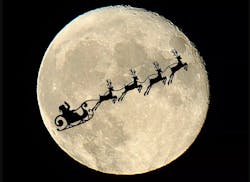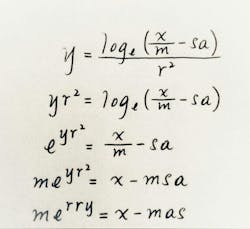Engineering Santa's Annual Globetrotting
EXPLAINING SANTA CLAUS AND HIS SLEIGH: A COMPARISON OF THE CLASSICAL PHYSICS AND QUANTUM MECHANICS THEORIES
A Dissertation presented
By ALABASTER SNOWBALL, MEA*
*Master of Elf Administration, University of the North Pole
Submitted to the Graduate School of the
University of the North Pole in partial fulfillment
of the requirements for the degree of
DOCTOR OF NOELOGY
December 2023
ABSTRACT
It has been well understood since the 3rd century that Santa Claus (a/k/a Saint Nicholas) is the patron saint of children.
However, it was not until the early 19th century that S. Claus was able to harness the technology needed to deliver toys to all of the world’s (well-behaved) children. There are approximately 2 billion children, aged zero to 14-years-old in the world today. With a global average of 2.3 children per mother (global fertility replacement rate or TFR), that would indicate a total of 869,565,217 child-occupied households.
With approximately 24,642,757 square miles (63,824,448 sq km) of habitable land on the planet, that would make the theoretical average density of child-occupied households per square mile to be 35.3 (13.6 households per sq km). So the average theoretical distance between each household is 1/35.31/2 or 0.17 miles (0.27 km).
Disregarding the distance from the North Pole to the first stop, which is known only to S. Claus, he has to travel approximately 147,826,087 miles between sunset in the first applicable time zone (also accounting for the International Date Line) and sunrise in the last time zone, a period of approximately 31 hours.
That means that S. Claus has 128 microseconds per household for travel time; disembarkation from the sleigh, with presents; covert entry into the residence; delivery of presents and consumption of milk and cookies, where applicable; covert exfiltration from the residence, boarding sleigh, and takeoff. Arbitrarily assuming 50% of the total time is for travel, the minimum sleigh velocity required is 9,537,167 miles per hour (15,348,583 km/h).
Since the theoretical speed of light is 671 million mph (108 million km/h), classical physics allows the sleigh speed as possible. The physical model does not account for interference caused by aircraft, meteors, spacecraft, and satellites, nor does it address the heat loss and gain during the journey and the complex navigation and night vision systems that are required; those are best left to other researchers.
If we describe the Christmas Eve travel and delivery model in terms of quantum mechanics, we find the solution to be even more straightforward. Assuming that S Claus uses quantum superposition, then his position at any given time during the postulated Christmas Eve time period is not well-defined as it was in the classical physics model. In fact, it may not be known at any given time, since the quantum system
interacts in ways that can only be explained with superposition of different discrete states. In other words, measurements of S Claus’ quantum system gives a statistical result corresponding to any one of the possible states appearing at random. Like waves in the classical physics model, the multiple quantum states can be superimposed, resulting in another valid quantum state. For those interested in the mathematical explanation, it follows here:
Happy Holidays and best wishes for a healthy and happy 2024!
####
Author Larry Clark, aka Alabaster Snowball, has been a contributor to HPAC Engineering since 2013 and a member of its editorial advisory board. A proud Virginia Tech alum, he is a principal at Sustainable Performance Solutions LLC, a south Florida-based engineering firm focused on energy and sustainability. Contact him at [email protected].

